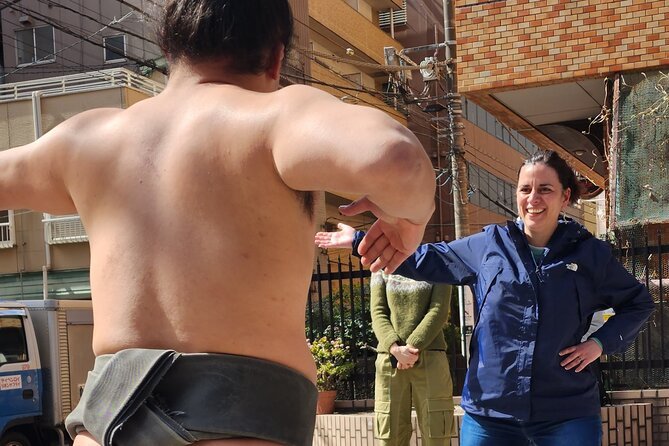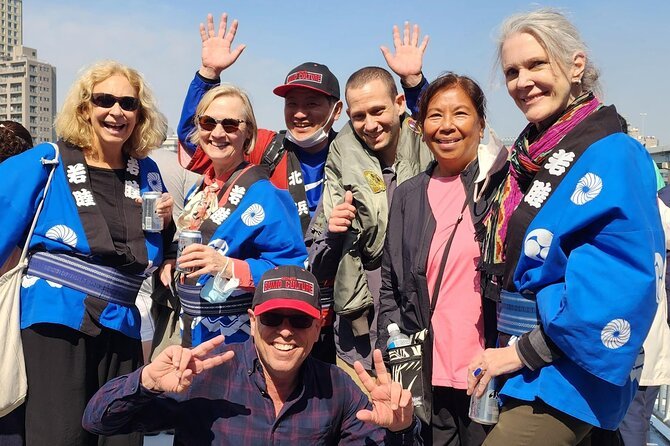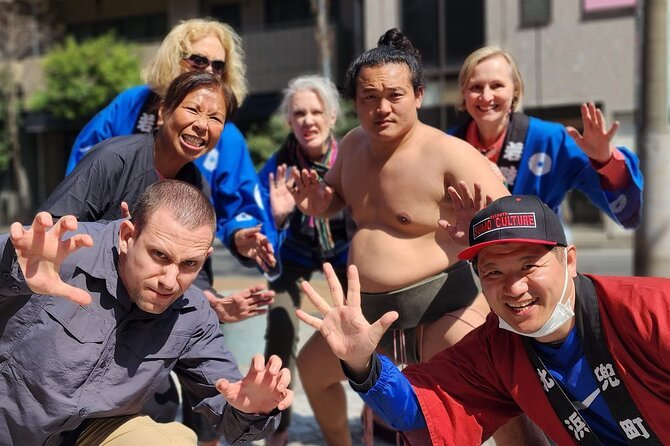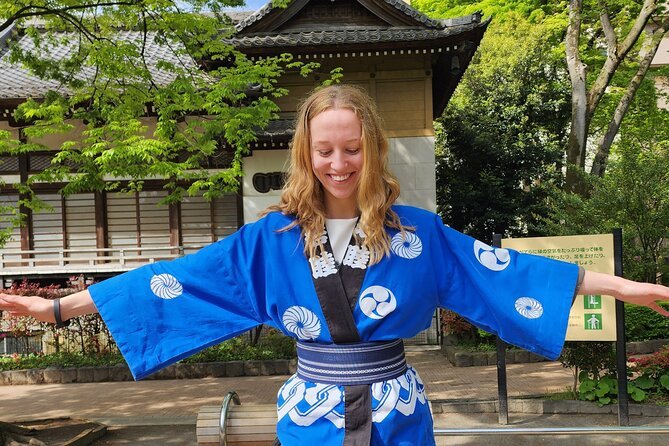In this exploration of ‘Secrets of Sumo Culture,’ we will uncover the fascinating world of this traditional Japanese sport.
We’ll dive into its history, rituals, and overall impact on Japanese culture.
From the bustling streets of Tokyo to the hidden aspects of sumo, get ready for an immersive journey that offers a comprehensive glimpse into the Japanese way of life.
Just The Basics

Sumo culture is fascinating and has a rich history with unique traditions. While we were in Tokyo, we had the chance to explore the city, try local food, and visit shrines and temples. We even got to witness some sumo demonstrations, which were really impressive.
Although we couldn’t go to where the wrestlers live and train, we still got a good understanding of what sumo is all about and why it’s important in Japanese culture.
Here's some other great tours and experiences nearby we think you'll like.
Sumo Culture: A Fascinating Tradition

Sumo culture is an ancient tradition in Japan that showcases the power and discipline of sumo wrestlers. It’s important to Japanese society and has been passed down through many generations.
Sumo matches are not just about physical strength, they also represent values like respect, discipline, and honor. The wrestlers follow rituals before the match and wear traditional attire, which adds to the significance of the sport.
Sumo culture is full of interesting traditions and symbolism, making it a fascinating and respected tradition in Japan.
Unveiling the History of Sumo
Sumo is a traditional Japanese sport that has a long and important history. It started a long time ago as a religious ritual and has now become a popular competitive sport.
Sumo wrestlers are seen as heroes in Japan and their tournaments attract big crowds and are shown on TV all over the country.
Sumo is not just about sports, though. It represents the values and traditions of Japanese culture and is a source of national pride.
The history of sumo shows us how important traditions are in shaping Japan’s identity.
Exploring the Sumo Training Rituals

Sumo wrestlers have unique training rituals that help them become strong and skilled in their sport. Every day, they go through a tough routine to build their muscles, improve their balance, and learn wrestling techniques.
Their training starts early in the morning with warm-up exercises. Then, they have intense practice matches and drills.
To keep their bodies in shape, sumo wrestlers follow a strict diet that includes lots of rice, protein-rich foods, and vegetables.
They also have to keep the training area clean and take part in special ceremonies to honor the traditions of sumo.
The hard work and discipline they put into their training rituals prepare them for the challenging world of sumo wrestling.
Discovering the Local Gems: Restaurant, Shrine, and Temple

This tour lets you explore some cool places in Japan – a restaurant, shrine, and temple – where you can learn about the country’s culture.
Here’s what you’ll get to do on the tour:
-
Try yummy food: At the restaurant, you’ll get to taste traditional Japanese dishes like udon. It’s a type of noodle soup that’s really tasty and famous in Japan. You’ll get to experience the real flavors of Japan and enjoy their amazing food heritage.
-
See interesting customs and rituals: The tour also takes you to a shrine and temple. Here, you’ll see how Japanese people follow their traditional customs and perform rituals. You’ll learn about the importance of these places and even get a chance to join in a traditional ceremony. It’s a cool way to get a glimpse into Japan’s deep-rooted traditions and beliefs.
-
Enjoy the culture: By visiting these local spots, you’ll get a better understanding of Japan’s cultural heritage. You’ll get to meet and talk to locals, learn about their customs, and see firsthand how Japan’s traditions shape its identity. It’s not just about seeing things, but really connecting with Japan’s soul.
Behind the Scenes: Insights Into Sumo Athletes’ Lives

Sumo wrestlers work really hard to be the best in their sport. They have a strict routine that revolves around their training and staying strong.
They wake up early in the morning, around 5 am, and eat a big breakfast to have energy. Then they go to the sumo training facilities, called stables, where they spend a long time practicing their moves and doing tough exercises to get stronger.
They also eat meals that have lots of calories and protein to help their muscles grow. In the evenings, they focus on relaxing and recovering by taking hot baths.
This disciplined lifestyle helps them become strong and respected sumo athletes.
An Intimate Sumo Experience: Training Session and Photo Opportunity
Experience the Secrets of Sumo Culture: Training Session and Photo Opportunity
During the ‘Secrets of Sumo Culture’ tour, participants have a special chance to witness an up-close training session and take memorable photos with sumo wrestlers. This unique experience gives you a peek into the intense training that these athletes go through to become masters of their craft.
Here’s what you’ll see:
-
Sumo Training Techniques:
-
Watch sumo wrestlers as they practice their moves, showing off their strength, balance, and agility.
-
See them do challenging exercises like leg stomping and hand clapping to stay in top physical shape.
-
Get a firsthand look at the wrestlers showcasing their grappling techniques, displaying their skill and expertise.
-
Cultural Significance of Sumo Photographs:
-
Taking photos with sumo wrestlers isn’t just exciting, it also has cultural importance.
-
These pictures become cherished keepsakes that represent a connection to traditional Japanese culture.
-
They capture the personal encounters participants have with these respected athletes, preserving the memories of their sumo journey.
This exclusive training session and photo opportunity give you an immersive and unforgettable experience, allowing you to dive deeper into the world of sumo.
Immerse in Japanese Culture: Udon Lunch and Cultural Highlights
On the ‘Secrets of Sumo Culture’ tour, you’ll get to experience more of Japanese culture.
We’ll start with a tasty Udon lunch in the Ryogoku district. Udon is a traditional Japanese noodle dish made with thick noodles in a yummy broth. It’s a popular comfort food in Japan.
After lunch, we’ll visit some cool places that are important to Japanese culture. We’ll see a Buddhist temple, a Shinto shrine, a Japanese garden, and a sports center. These places will teach us about traditional customs and the history of Japan.
It’s going to be a fun and educational experience!
Frequently Asked Questions
What Are Some Common Misconceptions About Sumo Culture?
Some people think that sumo culture is only about being big and strong. But actually, sumo is a sport that is rooted in tradition and discipline. It’s not just about size and power, but also about being quick and smart. Sumo wrestlers have to think strategically and show respect for the cultural heritage of the sport. So, it’s more than just a brute force competition.
How Did Sumo Wrestling Evolve Throughout History?
Sumo wrestling has changed a lot over time. The way the wrestlers fight and their strategies have improved over the years. Different things like old ceremonies, martial arts, and cultural customs have influenced how sumo has evolved. This has made sumo wrestling the strong and unique sport it is today.
What Are the Specific Rituals and Traditions Involved in Sumo Training?
Sumo training involves a lot of specific rituals and traditions. These rituals are important because they help the sumo wrestlers get physically fit, practice their techniques, and respect their culture. Sumo wrestling has been around for a long time and has changed over the years. Let’s dive into the details of what these sumo training rituals are all about.
Can You Provide More Information About the Local Restaurant, Shrine, and Temple Visited During the Tour?
During the tour, you’ll get to visit a local restaurant, shrine, and temple. These places are really cool because they teach you about the traditional food, culture, history, architecture, and religion of the area.
At the restaurant, you’ll get to try some delicious traditional dishes. It’s a great chance to taste new flavors and learn about the local cuisine. You might even discover some new favorite foods!
The shrine is a special place where people go to worship and show respect. It has a lot of cultural significance and is an important part of the community. You’ll learn about the customs and traditions associated with the shrine, and why it holds such importance to the local people.
The temple is another interesting stop on the tour. It has a rich history and beautiful architecture. You’ll get to see all the unique features of the temple and learn about the religious practices that take place there. It’s a peaceful and serene place where people come to pray and find inner peace.
What Is the Daily Life and Training Routine Like for Sumo Athletes?
Sumo athletes have a strict daily routine that includes tough exercises, intense wrestling practice, and a special diet. Their diet, called chankonabe, is packed with protein to give them the energy they need for their challenging training sessions. Sumo training is not just about getting strong physically; it also teaches discipline, mental toughness, and a strong respect for tradition.
Last Words
The world of sumo culture is really interesting and mysterious. It has a long history and some cool traditions.
We learned a lot about it by exploring the streets of Tokyo, trying local food, and visiting shrines and temples. We even got to see some sumo demonstrations, which were really cool.
We couldn’t go to where the wrestlers live and train, but we still got a good idea of what sumo is all about and how it’s an important part of Japanese culture.
